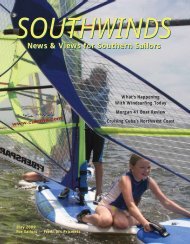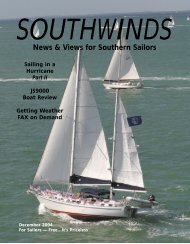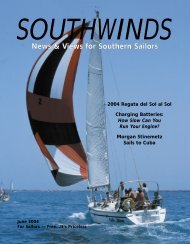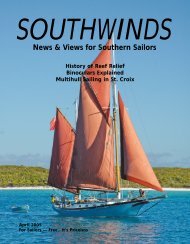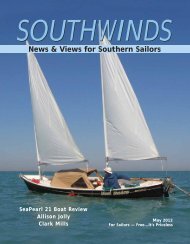Read PDF - Southwinds Magazine
Read PDF - Southwinds Magazine
Read PDF - Southwinds Magazine
You also want an ePaper? Increase the reach of your titles
YUMPU automatically turns print PDFs into web optimized ePapers that Google loves.
RACE TIPSAroundthe Buoys:TurningThe CornerBy Dave EllisRacing your PHRF keelboat around the buoys involvesmuch more than maintaining the best speed. Howmany times have you looked at the results and found avery few seconds separating boats after the handicaps areapplied?Just as in one-design racing, it is the corners wheremuch time is gained or lost on a racecourse. What aresome techniques to save time on the all-important markroundings?It is amazing how often nobody on a boat knows exactlywhich direction to go after a turn. There should be somebodyaboard who is familiar with the course so that thehelmsman knows how far to turn. Sometimes the “lemmingeffect” takes charge, where everybody follows the first boataround, no matter which way it heads.Is there a tidal effect that would modify the course tosteer? Make a good guesstimate of that course before theturn. The GPS, if allowed, will tell you after you have gonea ways. But that may be after you have lost a few secondsto another boat.When a turn involves hardening up into the wind,make sure the mainsail is trimmed a little faster than itshould be. The genny should NOT be trimmed very fast. Itinhibits the turn. Hot-shot one-designs often let the jib luff alittle as they pull it in slowly in the turn and only bring it toideal trim after the boat is on course.When falling away from the wind, the opposite is true.As a matter of fact, the main must be “dumped” aggressivelywhen falling away from the wind in a blow. Many a boathas broached back to windward when it heeled over too farwhen turning down. Let that main out and keep the jib fullfor a smooth turn off the wind.As for the turn itself, know your boat. A Hunter 465has a different optimum turning radius at various speedsthan does an SR Max or Martin 242. During a day sail, tryvarious rates of turn for various wind strengths and seaconditions. If a turn is simply a few degrees, there is notmuch to it.But when a turn of 90 degrees or more is involved, theangle of the rudder is a significant brake if there is morethan one full turn on the wheel or more than 45-degrees offcenter on the tiller.Strive to make the turn with few or no whirlpools in thewater behind the boat. Those whorls of water demonstratemassive energy loss, meaning that the boat has slowed. In50 January 2006 SOUTHWINDS www.southwindsmagazine.com



